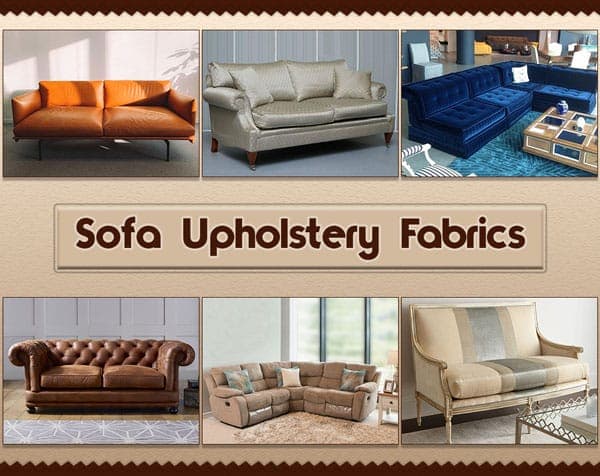
A beautiful and comfy upholstery gives life and charm to any sofa. You can choose to feel serene, pumped or elated just with a blend of coloured cushions and comfortable upholstery, which in turn is synchronous with the room wall decor. According to ‘the house book’ (Published by Parragon), ‘Fabric for a seating should be closely woven, hardwearing, crease-resistant and flame-resistant.’ Choosing the right sofa upholstery can sometimes be tricky if you are unaware of the potential problems that arise from a wrong choice of material. Ask a homemaker, and you’ll find more of them dissatisfied with their sofa upholstery rather than the framework. Moreover, there’s nothing more distressing as much as damaged sofa upholstery, that necessitates a complete makeover for the entire couch.
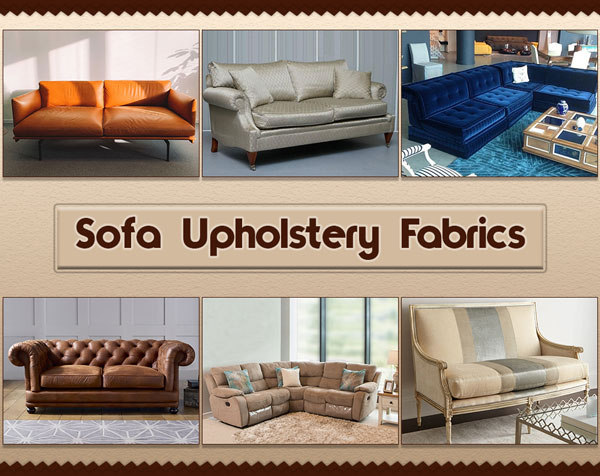
So, how would you know what’s the right upholstery for your needs? What are the types of materials used? What are the pros and cons of each material? Fret not; this article will address all your issues and subsequently help you choose the perfect upholstery for your sofa.
The classification of best upholstery fabrics can be broadly classified into Natural and Synthetic. The following list will give you an overview of the commonly used upholstery material:
Natural Upholstery Material
- Leather
- Suede
- Cotton
- Wool
- Linen
- Silk
- Velvet
01. Standard Leather Upholstery
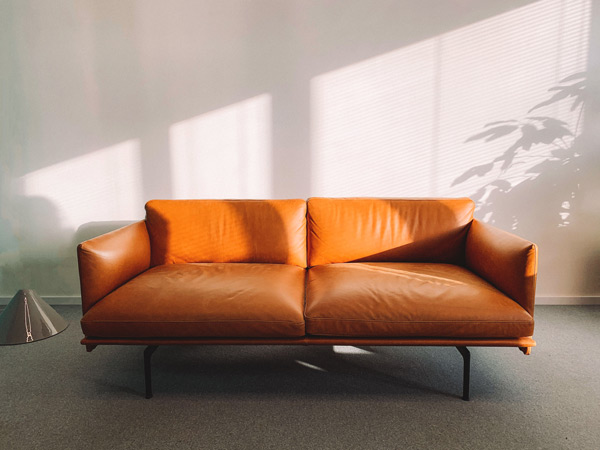
It is naturally available and is made by tanning animal hides and skins. Of the three types of leather, the full-grain (a type of top-grain leather) is commonly used to make sofa upholstery. It is obtained from the tough outer skin of animals. It is the highest quality leather and therefore, doesn’t wear out with time. Instead, it is known to appear refined and aesthetic by the development of a sheen on its surface.
Pros:
- Beautiful and classic appearance.
- Comfortable.
- It lasts for a long time with proper maintenance.
- It collects less dust and mites. Hence less allergenic.
- Easy to clean.
Cons:
- The manufacturing process involves animal cruelty.
- Because it is of the finest quality, full-grain leather is the most expensive one.
- Contributes to carbon footprint by manipulating natural resources in animal rearing and leather production. Livestock rearing accounts for 18% of man-made greenhouse gas emissions.
- Air and Water pollution – It is caused by the use of pesticides, heavy metals and chemicals in tanning processes.
- Leather takes 25-40 years to decompose.
- Exposure to high heat causes cracks in leather upholstery.
- Not puncture resistant.
02. Suede Sofa Upholstery

It is a type of leather with a feel of “raised fibres” (napped), like the way they are on velvet. Unlike the top grain leather, suede is made from the inner side of the skin, due to which this material is soft and less durable than standard leather. Its original intended use was for making women’s gloves.
Pros:
- It looks like leather and less expensive.
- Softer than leather, comfortable.
Cons:
- Soft, hence prone to damage.
- It Absorbs water.
- It Stains easily. Therefore, it requires a protective covering.
03. Cotton for Sofa Upholstery

Cotton is derived from the seed hairs found in seed pods of the cotton plant. Most of the upholstery material is made of cotton blends with cotton making up 45%-60% of the fabric.
Pros:
- Withstands fading when not exposed to direct sunlight.
- Canvas weaves are more durable. Durability depends on the quality of the weave.
- It is a breathable fabric.
- Machine washing and detergents can do the cleaning.
- Not sensitive to static discharge.
Cons:
- Prone to wrinkles.
- Highly flammable.
- It has an affinity for moisture and sunlight.
- The low-quality cotton fabric wears and tears easily.
04. Wool for Sofa Upholstery
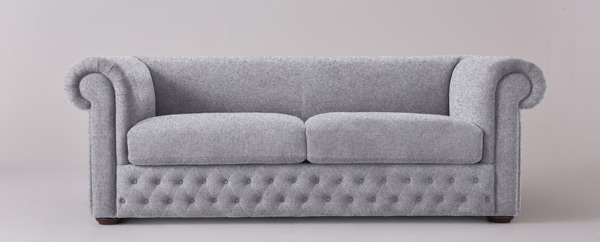
It is derived from animal hair. Most of the woollen upholstery is a blend.
Pros:
- Durable and strong.
- It Doesn’t wrinkle or fade.
- Best fire-resistant fabric.
Cons:
- It feels a little scratchy.
- Difficult to clean if it is not blended with other fibres.
- Can harbour moths. It has to be made moth-proof before using in upholstery.
05. Linen for Sofa Upholstery
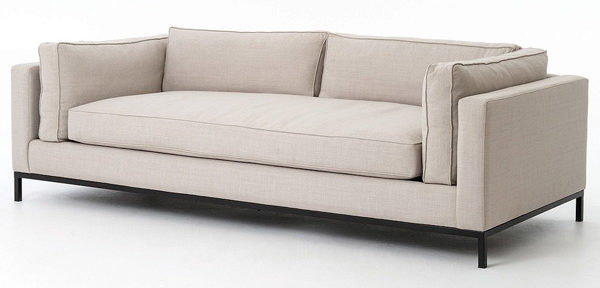
It is manufactured from flax. When combined with cotton, it exhibits excellent elasticity. According to ‘the house book’ (Published by Parragon), ‘Linen is a strong natural fabric. It is available in different weights. It is expensive and creases very easily, but it feels luxurious.’
Pros:
- Soft and smooth.
- Lustrous
- Linen doesn’t pill.
- It resists soiling.
Cons:
- Not resistant to spills and stains.
- It fades and has to be cleaned through dry cleaning.
06. Silk for Sofa Upholstery
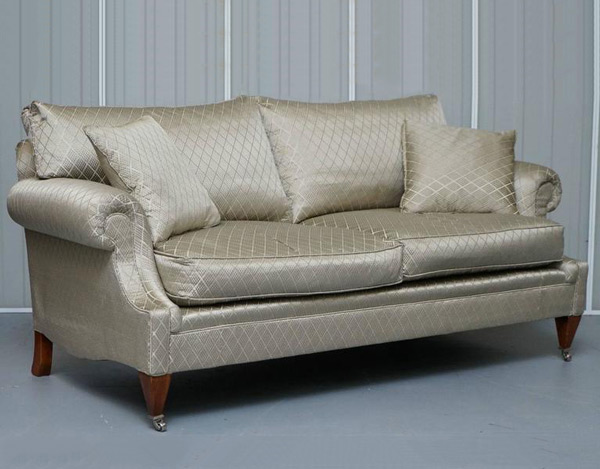
With its lustrous sheen and smooth texture, the silk is the most luxurious and expensive material to adorn a home. Silk can be woven with different patterns, colours and embroidery. Silk is apt for sofas decorating formal rooms.
Pros:
- Silk is hypo-allergenic. Dust mites do not settle in silk.
- Mould and insect resistant.
- Strong and soft to touch.
- It gives a royal look to home decor.
Cons:
- It stains quickly.
- It requires professional cleaning.
- Fibres are damaged when exposed to sunlight.
- Not suited for rough or daily use.
- Difficult to maintain.
07. Velvet for Sofa Upholstery

Velvet is made from synthetic materials like polyester or natural ones like cotton and silk. Though it is delicate for everyday use, polyester derived velvet is more durable and comparatively easier to clean than other types of velvet. According to ‘the house book’ (Published by Parragon), ‘Velvet has a wonderful direction of pile which must be used in the same direction.’
Pros:
- Very comfortable and ultra-soft texture.
- Available in a variety of colours.
- It renders a plush look.
Cons:
- Not suitable for everyday use.
- Cleaning is difficult. The upholstery should not be rubbed to remove dirt.
- It attracts animal hair.
- Fairly expensive.
- Heat damages velvet.
(b) Synthetic Upholstery Material
- Rexine
- Artificial leather
- Faux suede
- Microfiber/ Microsuede
- Rayon/ Viscose (semi-synthetic)
- Olefin
01. Rexine Sofa Upholstery

It is an imitation leathercloth fabric design developed and produced by Rexine Ltd. of Hyde, England. Rexine is referred to as “Poor man’s leather”.
Pros:
- Inexpensive
- Cruelty-free
- Easy to clean
Cons:
- It retains heat. Not ideal for hot and humid climates
- It tears easily.
- Non- biodegradable but can be recycled
- Can be disastrous in cases of fire accidents as it is highly inflammable.
02. Artificial Leather Sofa Upholstery

Also known as faux leather, leatherette, Vegan leather, PU leather. It is made from PVC or PU plastic. Artificial leather is used extensively as a substitute for genuine leather. Pleather is a type of new artificial leather made by bonding plastic and fabric. The term ‘Pleather’ is a combination of the two words- plastic and leather.
Pros:
- Inexpensive
- Cruelty-free
- Gives an elegant look similar to leather.
Cons:
- PVC is not biodegradable
- Not eco – friendly material. Cancer-causing agents are released during its manufacturing.
03. Faux Suede Sofa Upholstery
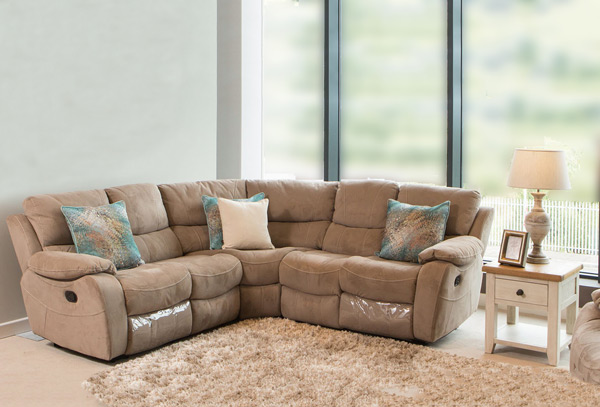
Faux suede is similar to real suede, but has short fibres and is not made of animal skin. It is a polyester fabric.
Pros:
- Easy maintenance
- Soft to touch and cosy to sit.
- Durable, easy to clean
- Cost is lower than that of genuine suede.
- Cruelty-free.
Cons:
- It is prone to discolouration when rubbed with water
- Cleaning technique is sensitive and requires specific cleaning materials.
04. Microsuede/ Microfiber Sofa Upholstery

Microfiber is a fabric having fibre diameter half that of silk and a hundred times finer than a human hair. Synthetic microfibers are made of polyester, nylon, acrylic or rayon.
Microsuede is a newer and purest polyester fabric with numerous tightly woven, microfibers. It imparts the classy napped look of genuine suede while being wear-resistant. Initially, it was called ‘Ultrasuede’. Microsuede is a beautiful combination of luxury and comfort and has none of the disadvantages of suede leather.
Pros:
- Repels water and therefore it doesn’t stain.
- Easy cleaning. Simple water and soap will clean the upholstery effectively.
- This fabric is machine washable and can be dried on a clothesline.
- The fabric is breathable. That means it feels cool in summer and warm in winter.
- Available in various colours.
- Lightweight.
- Inexpensive than real suede.
- Pet-friendly – the non-woven nature of the fabric discourages clawing and hence it is scratch resistant.
Cons:
- Microfibers attract and trap dust and grease.
- The manufacturing process contributes heavily to environmental pollution.
- The subtle nature of the fibre makes it conducive to heat and therefore, susceptible to fire accidents.
- Not available in a variety of textures and patterns.
05. Rayon/Viscose for Sofa Upholstery
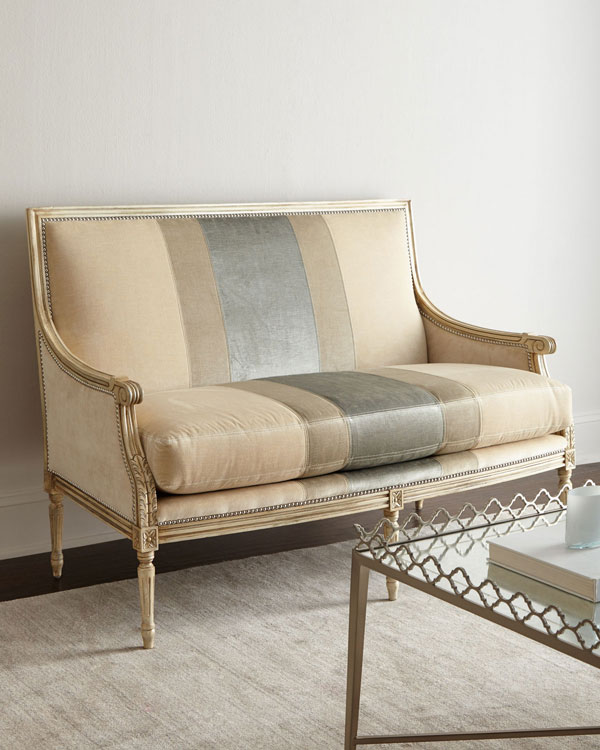
It is a semi-synthetic fabric made from regenerated cellulose. Rayon, when used for upholstery and other household items, is called Viscose. It is also called as imitation or artificial silk. It is absorbent, soft and similar to other natural fibres, but it is extremely flammable. Rayon shrinks or stretches, doesn’t retain its original shape, wrinkles, weak and is not durable. It requires dry cleaning.
06. Olefin for Sofa Upholstery
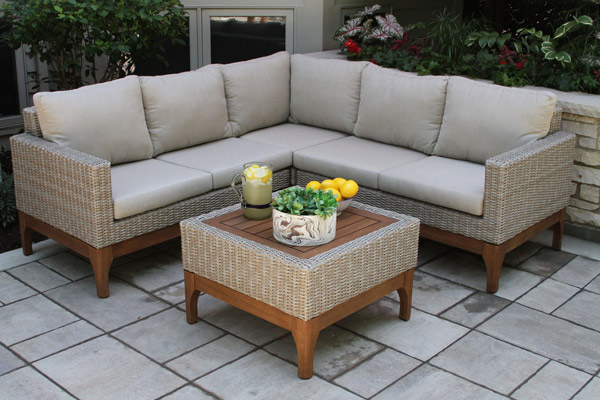
It is a polypropylene product derived from ethylene and propylene. Olefin has a wax-like feel.
Pros:
- Environment-friendly manufacturing process. It is a material with the lowest carbon footprint than cotton or wool.
- Fibres are recyclable
- Mildew, moisture and chemical resistant. Dries rapidly if wet.
- Olefin inherently doesn’t take up stain owing to its chemical structure.
- It doesn’t require additional anti-microbial, fire retardants or PFC (Perfluorinated compound) treatments.
- Strong and light. It retains its shape.
- Easy to clean
- Doesn’t give off static electricity
- Has good abrasion resistance
Cons:
- Heat sensitive. Olefin breaks down and melts in high temperatures. Hence not much suited for outdoor sofa furniture.
- It should be cleaned carefully and tumble dried or line dried under shade.
General Considerations before Choosing a Sofa Upholstery
- Rub a piece of upholstery fabric against your cheek to check for its smoothness. That way, you wouldn’t end up with a scratchy, uncomfortable sofa upholstery.
- The durability of the upholstery fabric is checked by “double-rubs”. ‘Double-rub’ is a test that measures the wear resistance of a fabric. It is done by measuring the amount of loss of substance from the surface of the test fabric by moving a cotton cloth (duck cloth) to and fro on the sample fabric. Each back and forth rub constitute a single rub. The more the rubs, the higher is the durability. Most residential sofa upholstery fabrics fall in the range of 15,000 to 30,000 double-rubs.
- Some fabrics are susceptible to pilling. Pilling simply means that the fibres of the weave form a fluffy ball due to continuous friction. Look out for fabrics that resist pilling to prevent the unsightly appearance of your couch.
- If you need upholsteries made purely of natural fibres without the use of blends, then you should check for the label ” certified organic”.
- Look for labels that denote the method of cleaning of upholstery fabric.
Obtain swatches of upholstery material to collate and decide on the right one for your needs.
Summary
- Leather upholstery is the best in preventing allergies caused by dust and dust mites. Tight weave fabrics are also hypoallergenic.
- If you are against animal cruelty, synthetics like microfiber, faux suede and natural fabrics like cotton will be suitable for your needs.
- Choose fabrics with higher Higgs index score for eco-friendly material. For instance, polypropylene, cotton and silk have higher Higgs index. Higgs index is a tool utilized by apparel and footwear companies to assess a product’s sustainability in respect to the environment and human health, from its beginning at the source to its completion as a product and to the end of its life cycle.
- Pet and children friendly upholstery includes fabrics made of microfiber, microsuede.
- Upholstery fabrics that are easier to clean are Rexine, artificial leather, standard leather, microfiber, microsuede.
- Cotton, linen, synthetic microfiber, and olefin are more durable.
- Pet-friendly upholstery: microfiber and leather are resistant to stain and clawing. Cotton and linen stains. Suede is difficult to clean. Velvet and silk upholsteries retain pet hair.
- Synthetics, cotton and blended fabrics are budget friendly.
Summing up, there’s no “one size fits all” kind of sofa upholstery. According to ‘the house book’ (Published by Parragon), ‘Choosing a furnishing fabric is a decision that must not be rushed. You will want to live with your choice for many years, so the fabric needs to be a pleasure to look at as well as being practical.’ Every material that has even been invented, discovered and used over the years has its inherent strengths and weaknesses. Many have failed the test of time while few others have incorporated improvements and have emerged as successful products. I hope this article gives you enough information on upholsteries to make an informed decision as you venture upon buying the sofa that you always dreamed of lounging on.
Also Read:
Exclusive Sofa Designs for Living Room
How to Select a Sofa for Optimum Comfort?
9 Secrets of Perfect Interiors for Your Home!
Image Courtesy – Image 3, Image 4 – reggiewilliams, Image 5 – sixpenny, Image 6, Image 7, Image 8, Image 10, Image 12 – mizunowa, Image 13, Image 14
Author Bio
Preema Pinto






























